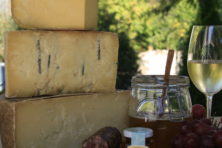The Cheese Insider
- Share
- Tweet
- Pin
- Share
There are many different methods and cheeses than can be used in cooking. We all have our favorites, and we also tend to blend those methods with the seasons. The warm and tasty fondues of winter give way to the fresh cheeses and salads in the summer. There are literally hundreds of ways to use some variety of cheese in cooking.
The harder cheeses – Parmesan, Gruyere, and cheddar have always been the most common types of cheese used in cooking. Their good melting properties make them ideal for sauces, pasta, and gratins. Blue cheeses add real depth of flavor, and the pungent ones, like Roquefort should be added sparingly. Soft rind cheeses such as Brie and Camembert are rarely used in cooking, the rind portion of the cheese makes it wasteful. They can be used by melting on the top of soups, breads, or can be baked whole. I have always been a big fan of baked Brie, served with fresh cut apples and a good loaf of French bread.
All cheese reacts differently depending on how it is cooked. The main principle is that it should not be exposed to high heat. Overcooked cheese tends to be rubbery. Above a certain temperature the protein in cheese coagulates, separating the fat from the water, something you want to avoid. One of the secrets is to add the cheese towards the end in the cooking process. If you are using it in a sauce, always take the pan off the heat and allow the cheese to melt in.
Harder cheeses can withstand higher temperatures than softer varieties. Some of the softer cheeses are best cooked quickly at a much higher temperature. The best example is mozzarella used on pizza, cooked in the super high heat of an oven.
The high fat or water content of many fresh, soft cheeses, means that they blend easily with a liquid making them very useful for vinaigrettes and other uncooked sauces. Fresh goat cheese does very well when mixed with a quality vinegar drizzled over a fresh bed of greens. Our garden at home has a bountiful supply of greens this time of year, and we always find a way to combine them with any number of good fresh cheeses like chevre.
Here is a recipe for you to try on a warm summer day:
Goat Cheese & Cumin Vinaigrette
Makes about 1 ¼ cups
Ingredients
4 oz. (about ½ cup) soft, mild goat cheese
2 tablespoons hot water
2 tablespoons red wine vinegar
½ tablespoon ground cumin
1 tablespoon fresh chopped oregano
1 egg yolk
7 tablespoons vegetable oil
Salt and fresh ground pepper
Directions
Put the goat cheese in a bowl, pour on the hot water, and beat until smooth and creamy. Add the vinegar, cumin, oregano, and egg yolk and whisk together until blended. Gradually whisk in the oil and then season to taste, being careful with the amount of salt you add as some goat cheese tends to be rather salty.
Serve over a bed of greens, or fresh vegetables, and enjoy.
Source: A Passion for Cheese, Paul Gayler, 1998



